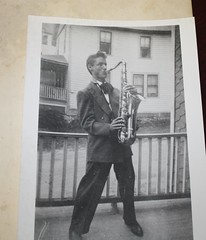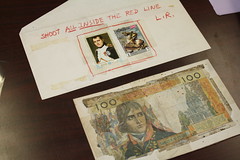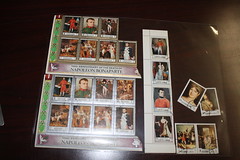 Courtesy Fales Library Archivist Nicholas Martin installing “Crossings: Larry Rivers & His Milieu” at Fales Library’s gallery.
Courtesy Fales Library Archivist Nicholas Martin installing “Crossings: Larry Rivers & His Milieu” at Fales Library’s gallery.An East Village poet, musician, and artist considered by many to be a godfather of Pop art has returned to his alma mater: this Friday, N.Y.U.’s Fales Library will host a day-long symposium celebrating its acquisition of the Larry Rivers Papers.
Marvin Taylor, director of Fales Library, said the treasure trove of letters, manuscripts, and video is in keeping with previous additions to the Downtown Collection, including the papers of Richard Hell and the Nightclubbing archive featured weekly on The Local. The collection of over 1,000 media elements — including manuscripts of poems Rivers received from John Ashbery and Kenneth Koch, audio recordings, and reel-to-reel videos that are currently being digitized — was acquired in 2010 and, after extensive processing, will be viewable by appointment starting next week.
Among the correspondence with friends such as Allen Ginsberg, Abbie Hoffman, and Maxine Groffsky are letters between Mr. Rivers and the great New York School poet, Frank O’Hara. “They collaborated on artworks, they collaborated on poetry, they were lovers,” said Nicholas Martin, the project archivist. “They had some really tumultuous times personally, and Frank O’Hara was just such a strong personality that his letters are outstanding.”
Mr. Rivers, born Yitzhok Loiza Grossberg to Russian-Jewish parents in 1923, was no less of a firebrand: in many of the letters, he apologizes to friends for making a scene at their events, said Mr. Martin.
The Larry Rivers Foundation, which sold the collection for an undisclosed amount (it was purchased with “generous help from donors,” said Mr. Taylor), has decided to hold on to the considerable amount of art Mr. Rivers left behind, but it parted ways with source material for the work, including 95 binders of photographic material. Rivers “never started a work of art as a spontaneous moment of divine inspiration,” said David Joel, the foundation’s president. “He researched it; he studied it. He really examined every aspect of it.”
The result, said Rob Slifkin, an N.Y.U. professor who will speak at the symposium, is art that “occupies a kind of crucial position between abstract expressionism and the emergence of pop art,” falling somewhere between Jackson Pollock and Andy Warhol. But unlike those artists, Mr. Slifkin said, Rivers displayed an “overt and unembarrassed engagement with political issues” and a preoccupation with race.
Long before Rivers took up painting, he was a jazz musician (he befriended Miles Davis while they were classmates at the Juilliard School of Music). The white saxophone player’s “embrace of the Black experience through his interest in jazz gave him a privileged position to be postmodern, to reevaluate conventional understanding of what art is, what painting is,” Mr. Slifkin said.
Howard Brofsky, a music professor at N.Y.U. and C.U.N.Y., played alongside Rivers in two bands, and will share two recordings of their music during the symposium’s panel on jazz. Mr. Brofsky said Mr. Rivers wasn’t the most exceptional jazz musician, but he had “a certain quirky, individual style” of writing music that made him stand apart from the rest.
Daniel Kane, a reader in English and American literature at the University of Sussex, is flying in to moderate the panel entitled “Literary and Artistic Circles” and to participate in a panel on poetry. He first heard about Mr. Rivers in his teens, through the work of Frank O’Hara and Allan Ginsberg, and was attracted to the Renaissance man’s “capaciousness and naughtiness.”
“He laughed in the face of professionalism and tried everything — films, drugs, painting, acting, set design, music, homosexuality, family life,” said Mr. Kane. “When he became famous as a painter — a fame built in part on his provocative rejection of abstraction in favor of a campy figuration — he almost immediately started experimenting with other artistic forms, including building set pieces for theater, making sculptures and installations, and beyond. Some of the works were great, and some of them were crap, but so what?”
Even in Mr. Rivers’ autobiography, “What Did I Do?”, he’s “acting out in order to keep us constantly, productively unsettled,” said Mr. Kane. “That is to say, the moment you think you know who this guy is (i.e., a musician; a proto-Pop painter; an Underground Film actor) he’ll pull the rug out from under you and challenge all your preconceptions about not just who he is but of what we are and how we should act in the world.”
“Crossings: Larry Rivers and His Milieu” on Friday, March 29 from 9:00 a.m. to 5:00 p.m. at N.Y.U.’s Fales Library, Elmer Holmes Bobst Library, 70 Washington Square South (at LaGuardia Place), third floor. RSVP at rsvp.bobst@nyu.edu.







